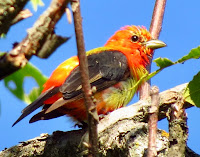The creepy crawlies turned out to be not only beneficial but crazy interesting, and intriguing, and got us totally involved in our yard.
1,000 Insect Species Found in our One Acre Jericho, VT. Yard
We started out wanting to make our yard a bird sanctuary.
We learned that a single pair of breeding chickadees must find 6,000 to 9,000 caterpillars to rear one clutch of young, according to Doug Tallamy, a professor of entomology and wildlife ecology at the University of Delaware. His research shows that native plants are integral food sources for plant-eating insects in a way that non-native plants are not.
We reduced mowing to only pathways and areas we utilized - (if we don't walk or play on it, and can't eat it, why mow it?). Then we added many species of native shrubs, trees*, and a few perennials each year - plants that feed caterpillars and pollinators. We also left the leaves and plant stems in the fall. We built brush piles and dug covered depressions for frogs, toads, snakes, and insects to use for home-building and raising their young.
*A subset of our plantings include Nannyberry, blackberry, three cherry bush species, one cherry tree species, blueberry, chokecherry, chokeberry, American cranberry, winterberry, snowberry, elderberry, red raspberry, purple flowering raspberry, ground nut, hazelnut, New Jersey tea, witch hazel, buttonbush, various dogwood species, crabapple trees, yellow birch and two other species of birch, oak, hemlock, spruce, various serviceberry species, cedar, tamarck, balsam fir, red maple, redbud, mountain ash, sumac, willow, hawthorn, alder, and a variety of apple trees.
Now we are spending more time in our yard observing. Observing the changes in our landscape, ever-increasing, season-long flowering, insect and bird diversity, and their life behaviors. One does not need to be an Emily Dickinson, or Charles Darwin to be committed to the close examination of nature. As they were, we are enchanted by the wondrous complexity of nature.
I started a dedicated approach to observing and recording insects in the yard in 2020 ( I call it 'inverting'). iNaturalist reports that I recorded nearly 1,000 insect species from 2020 to July 2024 in our yard. A few were the first (on iNaturalist) reported as observed in Vermont. *There are approximately 21,400 species of invertebrate species in VT. (VT F&W).
With this baseline count and the calculated ratios between flowering plants, we might eventually be able to assess how adding more native plant species might affect the volume and the diversity of insect and bird life we observe in our yard.
We believe that the overall number of native plants closely reflects the species richness of invertebrate species. We are entertained and enriched as the diversity of life in our yard grows.
The insects and birds benefit from a food and shelter sanctuary. We gain from increased pollination and a more balanced insect diversity contributing to the health of our vegetable gardens. We enjoy viewing a greater diversity of birds in our yard. We also gain free time by spending less time mowing and weeding. Not the least is our gain in enjoyment walking the paths in our yard.
Part of the joy of 'inverting' for me, is trying to theorize or guess at the why behind some of the insect behaviors I observe. Sometimes the joy is connecting, by quietly watching with intent focus, or infrequently by petting a bumblebee or a butterfly as an individual will occasionally allow me to do. If I am too bothersome or overstay my visit, a bee will communicate to me by raising one leg or two or flying away.
The stories of what we have observed are many - too many to tell here now - more of those later. Added to the mix, the research I have read over the winter about individual bee species - develops a recipe of intrigue worth dwelling on further.
We are happy to utilize iNaturalist to share photos of the adorable, amazing, interesting creatures we have found in our one-acre yard. To browse the photos choose any of the links below.
- View my latest insect posts from our yard here.
- View the 100+ bee species observed in our yard here. There are 350+ species of bees in Vermont - who knew!

- Dragonflies and Damselflies (Odonata) here.
- Flies (Diptera) here. (Yes many fly species are pollinators)
- Or see a limited set of fly species photos at The Portrait of a Fly.
- Grasshoppers, crickets, and bush-crickets
- Ants, bees, and wasps (Hymenoptera) here.
- True Bugs, Hoppers, Aphids, and Allies (Hemiptera) here.
- Beetles (Coleoptera) here.
- Lady beetles or Ladybugs (Coccinellidae) here.
2016: 54, 2017: 59, 2018: 53, 2019: 61, 2020: 83, 2021: 80, 2022: 70, 2023: 78, 2024 through July: 72.
Total lifetime yard bird species: 126.
Recommended (aquatic invertebrate) reading: Turning Stones, - Discovering the Life of Water ( 50+ short essays) by local resident and Saint Michael's College professor Declan McCabe.
What species are in your yard?












Beautiful! Wonderful! Inspirational!
ReplyDelete